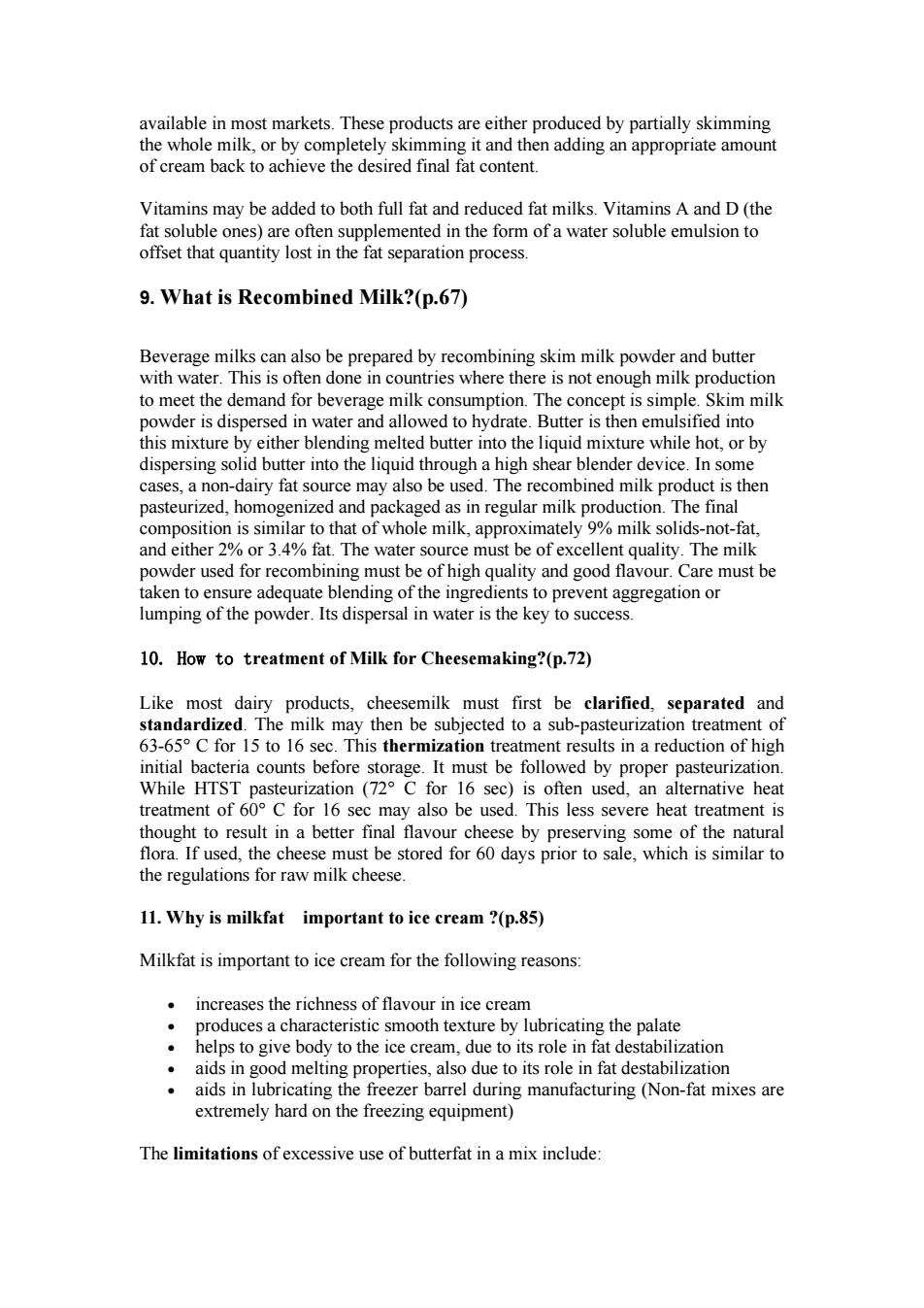正在加载图片...

available in most markets.These products are either produced by partially skimming the whole milk,or by completely skimming it and then adding an appropriate amount of cream back to achieve the desired final fat content. Vitamins may be added to both full fat and reduced fat milks.Vitamins A and D(the fat soluble ones)are often supplemented in the form of a water soluble emulsion to offset that quantity lost in the fat separation process. 9.What is Recombined Milk?(p.67) Beverage milks can also be prepared by recombining skim milk powder and butter with water.This is often done in countries where there is not enough milk production to meet the demand for beverage milk consumption.The concept is simple.Skim milk powder is dispersed in water and allowed to hydrate.Butter is then emulsified into his mixt丸re by either blending melted butter into the liquid mixture while hot,or by dispersing solid butter into the liquid through a high shear blender device.In some cases,a non-dairy fat source may also be used.The recombined milk product is then pasteurized, homo enized and pa ged as in regular mi produ e fina mpo mately and eithe 2% ole milk,approx T30 he n and g must be lumping of the powder.Its disper sal in water is the key to su 10.How to treatment of Milk for Cheesemaking?(p.72) oducts st first be clarified, ay then be subiected to a sub-pasteu ent of 63-65 C for 15 to 16 sec.This thermization trea atment results in a reduction of high initial bacteria counts before stor age it must he followed by oner pasteurization While HTST pasteurization (72C for 16 sec)is often used,an alternative heat treatment of 60 C for 16 sec may also be used.This less severe heat treatment is thought to result in a better final flavour cheese by preserving some of the natural flora.If used,the cheese must be stored for 60 days prior to sale,which is similar to the regulations for raw milk cheese. 11.Why is milkfat important to ice cream ?(p.85) Milkfat is important to ice cream for the following reasons ·: increases the e rich hness of flavou to to its r aids in melting rtie also e to its role in fat destabilization aids in lubricating the free ezer barrel during manufacturing (Non-fat mixes are extremely hard on the freezing equipment) The limitations of excessive use of butterfat in a mix include:available in most markets. These products are either produced by partially skimming the whole milk, or by completely skimming it and then adding an appropriate amount of cream back to achieve the desired final fat content. Vitamins may be added to both full fat and reduced fat milks. Vitamins A and D (the fat soluble ones) are often supplemented in the form of a water soluble emulsion to offset that quantity lost in the fat separation process. 9. What is Recombined Milk?(p.67) Beverage milks can also be prepared by recombining skim milk powder and butter with water. This is often done in countries where there is not enough milk production to meet the demand for beverage milk consumption. The concept is simple. Skim milk powder is dispersed in water and allowed to hydrate. Butter is then emulsified into this mixture by either blending melted butter into the liquid mixture while hot, or by dispersing solid butter into the liquid through a high shear blender device. In some cases, a non-dairy fat source may also be used. The recombined milk product is then pasteurized, homogenized and packaged as in regular milk production. The final composition is similar to that of whole milk, approximately 9% milk solids-not-fat, and either 2% or 3.4% fat. The water source must be of excellent quality. The milk powder used for recombining must be of high quality and good flavour. Care must be taken to ensure adequate blending of the ingredients to prevent aggregation or lumping of the powder. Its dispersal in water is the key to success. 10. How to treatment of Milk for Cheesemaking?(p.72) Like most dairy products, cheesemilk must first be clarified, separated and standardized. The milk may then be subjected to a sub-pasteurization treatment of 63-65° C for 15 to 16 sec. This thermization treatment results in a reduction of high initial bacteria counts before storage. It must be followed by proper pasteurization. While HTST pasteurization (72° C for 16 sec) is often used, an alternative heat treatment of 60° C for 16 sec may also be used. This less severe heat treatment is thought to result in a better final flavour cheese by preserving some of the natural flora. If used, the cheese must be stored for 60 days prior to sale, which is similar to the regulations for raw milk cheese. 11. Why is milkfat important to ice cream ?(p.85) Milkfat is important to ice cream for the following reasons: • increases the richness of flavour in ice cream • produces a characteristic smooth texture by lubricating the palate • helps to give body to the ice cream, due to its role in fat destabilization • aids in good melting properties, also due to its role in fat destabilization • aids in lubricating the freezer barrel during manufacturing (Non-fat mixes are extremely hard on the freezing equipment) The limitations of excessive use of butterfat in a mix include: